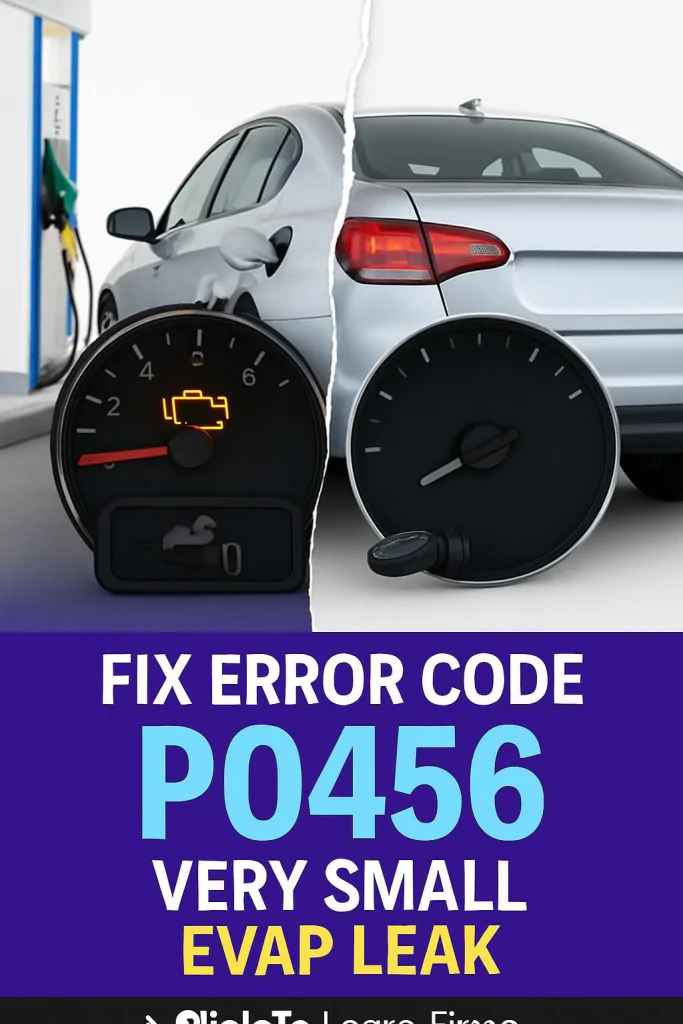P0456 – Very Small EVAP Leak Detected (Symptoms, Causes & Fix)

Ever had that dreaded Check Engine Light pop up out of nowhere, and your scanner throws a mysterious code at you: P0456 – Very Small EVAP Leak Detected? Yeah, I’ve been there. At first, I thought, “Great, my engine’s probably about to explode.” Spoiler: it wasn’t.
The EVAP (Evaporative Emission Control) system is one of those behind-the-scenes heroes that doesn’t get much love until something goes wrong. And when it does, it usually greets you with a code like P0456. Don’t worry though—this isn’t the end of the world. In fact, I’m going to walk you through exactly what it means, how it feels when it happens, what causes it, and most importantly, how to fix it.
So grab your OBD-II scanner, maybe a cup of coffee, and let’s dig in.
What Does Code P0456 Actually Mean?
P0456 is one of those OBD-II diagnostic trouble codes (DTCs) that’s emissions-related. It tells you the computer detected a very small leak in your EVAP system.
Quick Breakdown:
- EVAP System’s Job: Capture gasoline vapors from your fuel tank and prevent them from escaping into the atmosphere.
- When P0456 Pops Up: The system ran a pressure or vacuum test and realized it’s losing pressure somewhere—basically a leak smaller than 0.020 inches (that’s like a pinhole!).
- Severity: Annoying but not catastrophic. Your car will usually still run fine, but you can’t ignore it forever.
Think of it like this: your EVAP system is like a sealed soda bottle. A tiny hole in the cap won’t stop you from drinking it, but it’ll go flat if you don’t fix it.
Symptoms of P0456
So how do you know your car has an EVAP leak besides the scan tool tattling on you? Here’s what you might notice:
1. Check Engine Light (CEL)
The most obvious one. You’ll usually get the CEL glowing steady without any other dramatic symptoms.
2. Slight Fuel Smell
Ever walk past your car and catch a faint whiff of raw gas? That’s a classic EVAP issue sign.
3. No Real Driveability Issues
Unlike misfires or sensor failures, P0456 usually doesn’t affect how your car runs. You might even drive for weeks without noticing anything wrong—except that pesky light.
4. Failed Emissions Test
Here’s the kicker: even if your car feels fine, you’ll fail inspection until the EVAP leak is fixed.
Common Causes of P0456
Alright, let’s play detective. What’s actually behind this tiny leak? Here are the usual suspects:
1. Loose or Faulty Gas Cap
- Probably the most common reason.
- If you just fueled up and didn’t tighten the cap until it clicks, the system will think it’s leaking.
- A cracked or worn-out gas cap seal can also be the culprit.
2. Damaged EVAP Hoses or Lines
- Rubber hoses dry out, crack, or disconnect.
- Even a tiny pinhole can trigger P0456.
3. Faulty Purge Valve (a.k.a. Purge Control Solenoid)
- Stuck open or leaking purge valve = vacuum loss.
- Can trick the system into thinking there’s a leak.
4. Leaky Vent Valve or Vent Solenoid
- This valve lets fresh air in when the system purges.
- If it’s stuck or cracked, you’ll get the code.
5. Charcoal Canister Damage
- Rare, but it happens.
- Cracks in the housing or internal failure can cause small leaks.
How to Diagnose P0456
Here’s where we roll up our sleeves. Don’t worry, you don’t need a NASA lab—just some patience and maybe a few tools.
Step 1: Check the Gas Cap First
- Remove it and inspect the rubber seal.
- Look for cracks, dirt, or wear.
- Tighten it until it clicks at least 3 times.
- Clear the code and drive a few days.
Step 2: Inspect Hoses and Lines
- Visually trace EVAP hoses from the tank to the engine.
- Check for cracks, loose fittings, or disconnections.
- Don’t forget the filler neck area—it’s a common weak spot.
Step 3: Listen for Hissing or Smell Fuel
- Sometimes you can literally hear or smell the leak.
Step 4: Check Purge and Vent Valves
- Remove and test them if you’re comfortable with DIY car repair.
- A purge valve should hold vacuum when closed.
Step 5: Smoke Test (Pro Level)
- A smoke machine pushes visible smoke through the EVAP system.
- Wherever the smoke leaks out—that’s your problem area.
- Pro tip: Many shops will do this fairly cheaply if you don’t own the tool.
DIY Fixes for P0456
Alright, so you’ve tracked it down. Here’s how you can usually fix it yourself:
1. Replace the Gas Cap
- Costs: $15–$40.
- Easiest and most common fix.
- Always go OEM if possible—cheap aftermarket caps sometimes don’t seal properly.
2. Repair or Replace Hoses
- If cracked: cut out the damaged section and replace with new EVAP-rated hose.
- If disconnected: simply reattach and secure with a clamp.
3. Swap Out Purge Valve
- Usually $50–$100 part.
- Located near the engine bay.
- Plug-and-play for most cars.
4. Replace Vent Valve
- Often mounted near the charcoal canister or tank.
- Expect around $50–$120 for the part.
5. Charcoal Canister Replacement
- Rare but expensive ($200–$400).
- Usually only after everything else is ruled out.
Professional Help vs DIY
So here’s the big question: Should you fix it yourself or take it to a shop?
- DIY-friendly fixes: Gas cap, visible hoses, sometimes purge valve.
- Better left to pros: Smoke testing, vent valve or canister replacement.
If you’re handy and love tinkering (like me), you’ll probably enjoy hunting this one down. But if you’re short on time or patience, a shop can usually diagnose and fix P0456 in a day.
Can You Drive with Code P0456?
Short answer: Yes, but…
- Yes: Your car won’t stall, break down, or suddenly refuse to start.
- But: You’re polluting more, wasting a bit of fuel vapor, and risking inspection failure.
- Plus, that CEL might mask new codes if they pop up later.
IMO, it’s like driving around with a small cut—it’s not life-threatening, but why not just fix it?
Preventing Future P0456 Codes
Nobody likes seeing that CEL again. Here’s how to keep it away:
- Always tighten your gas cap properly after fueling.
- Replace old caps every few years as cheap insurance.
- Inspect hoses annually, especially if your car is over 10 years old.
- Avoid topping off fuel tanks—it can damage the canister over time.
- Schedule regular maintenance to catch issues early.
Quick Recap
Let’s wrap this up with the big takeaways:
- P0456 means a very small EVAP leak—usually not serious but can’t be ignored.
- Symptoms are mostly a check engine light and maybe a faint fuel smell.
- Most common cause: a loose or faulty gas cap.
- Other causes: hoses, purge valve, vent valve, or charcoal canister.
- Fixes range from a $20 gas cap to a $400 canister.
- You can drive with it, but you shouldn’t ignore it forever.
Final Thoughts
At the end of the day, P0456 isn’t the end of your car’s story—it’s just a gentle nudge from your vehicle reminding you that even small leaks matter. And honestly, catching this code early can save you headaches (and money) down the road.
So next time that CEL lights up and you see P0456, don’t panic. Start simple: check that gas cap, sniff around for leaks, and go from there. Who knows—you might even fix it in less time than it takes to binge your favorite show 😉.
And hey, if you’ve ever wrestled with P0456 before, what fixed it for you? Drop a comment or share your story—it might just help out the next frustrated driver staring at their scanner.


